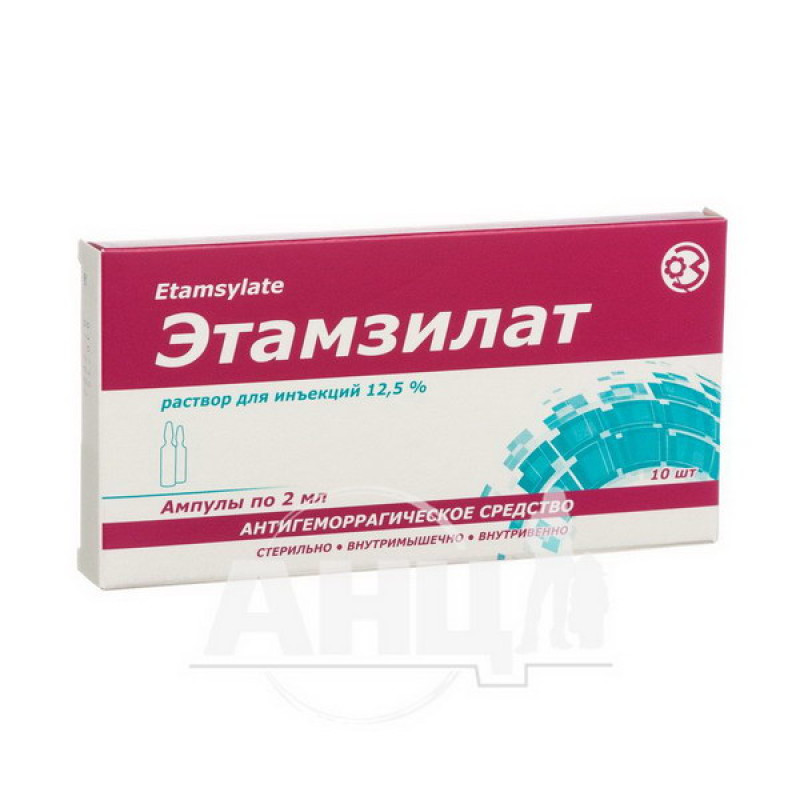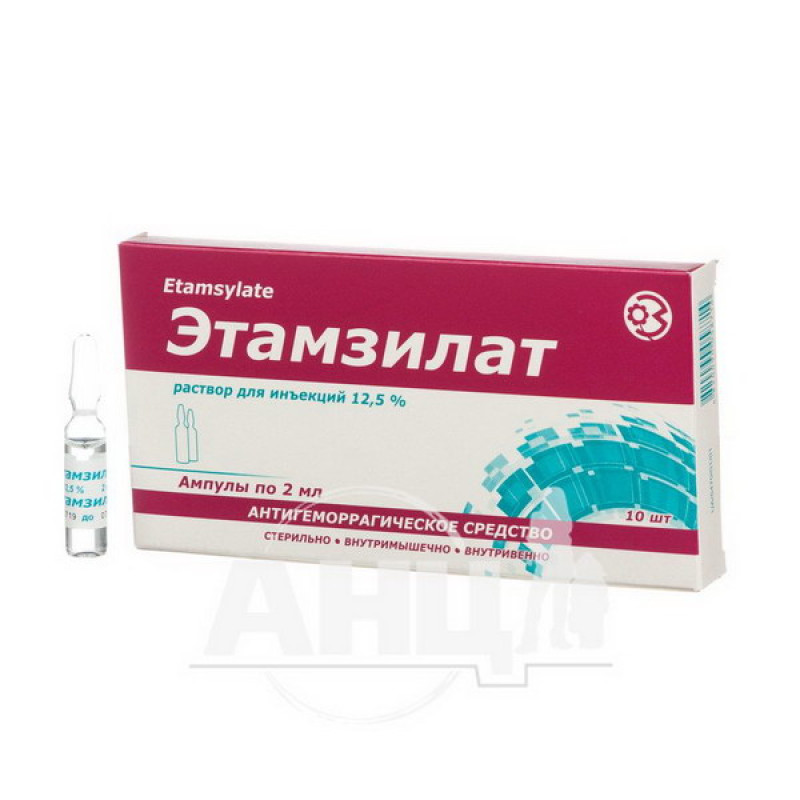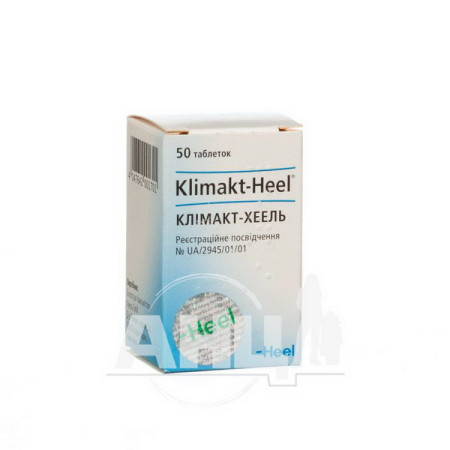***
Registration certificate
EN / 5470/01/01
dated 11/28/2006.
Etamzilate
Solution for injection. Trade name
Etamzilate international name
Etamsylate Latin name
AETHAMZILATUM General characteristics
International and chemical names: etamsylate; 2,5-dioxybenzenesulfonate diethylammonium salt;
Main physicochemical properties: transparent, colorless or slightly creamy liquid;
Composition: 1 ml of solution contains 125 mg of etamzilate;
excipients: sodium metabisulfite, sodium sulfite anhydrous, disodium edetate (Trilon B), water for injection. Release form
Solution for injection. Pharmacological
Hemostatic agents for systemic use.
PBX code V02V X01. Pharmacological properties
The drug has a hemostatic effect, the mechanism of which is not fully understood.
Etamsylate reduces the formation of prostacyclin (PGI2) in the vascular endothelium. This contributes to increased adhesion and then aggregation of platelets, which ultimately leads to the cessation or reduction of bleeding.
Etamzilate stimulates the formation of new platelets from megakaryocytes and their release from the depot, accelerates the formation of tissue thromboplastin, helps increase the rate of primary thrombus formation at the site of injury and enhances its retraction.
The drug enhances the formation of high molecular weight mucopolysaccharides in the capillary wall, increases capillary resistance, normalizes capillary permeability during pathological processes, and improves microcirculation.
During treatment with Etamzilat, pathologically altered hemostasis indicators, such as bleeding time, are restored, but this drug does not affect the normal parameters of the hemostasis system.
The hemostatic effect of intravenous administration of Etamzilat occurs after 5-15 minutes, the maximum effect - after 1-2 hours, the action lasts for 4-6 hours.
With intramuscular administration, the hemostatic effect occurs after 30 - 60 minutes. Pharmacokinetics
After intravenous or intramuscular administration of etamzilate at a dose of 500 mg, its plasma concentration after one hour is 30 μg/ml.
The half-life after intravenous administration is 1.9 hours, and after intramuscular administration, respectively, 2.1 hours.
95% of the administered drug binds to plasma proteins.
Etamzilate is not metabolized and is excreted from the body unchanged mainly in urine (80%), partially excreted in bile and feces. Indications for use
Prevention and stopping of capillary bleeding during surgical interventions in otorhinolaryngology (tonsillectomy, microsurgical operations on the ear), ophthalmology (keratoplasty, cataract removal, antiglaucoma operations), dentistry (removal of cysts, granulomas, tooth extraction), urology (after prostatectomy), surgery, and gynecology;
for injuries, diabetic angiopathy, hemorrhagic diatheses (including in emergency cases), as well as in emergency cases of pulmonary and intestinal bleeding. Method of administration and doses
Etamzilat is used intravenously, intramuscularly, injected under the conjunctiva and retrobulbarly. For the purpose of prevention, adults are administered intravenously or intramuscularly 1 hour before surgery at a dose of 0.25 - 0.5 g (2 - 4 ml of a 12.5% solution).
If necessary, during surgery, it is administered intravenously in a dose of 2 - 4 ml of a 12.5% solution.
If there is a threat of postoperative bleeding, 4-6 ml of a 12.5% solution is administered prophylactically per day.
For the purpose of treatment in emergency cases, Etamzilat is administered intravenously or intramuscularly to adults (2 - 4 ml of a 12.5% solution), and then 2 ml every 4 - 6 hours.
In the treatment of Metrorrhagia and Menorrhagia, Etamzilat is prescribed at 0.25 g (2 ml of a 12.5% solution) parenterally every 6 hours for 5-10 days, and then at 0.25 g (2 ml of a 12.5% solution) parenterally 2 times a day during the period of bleeding and 2 subsequent cycles.
For diabetic neuroangiopathy (hemorrhagic retinopathy), Etamzilat is prescribed intramuscularly (10-14 days) to adults, 2 ml 2 times a day.
Subconjunctivally or retrobulbarly (keratoplasty, cataract removal, glaucoma surgery) 1 ml of a 12.5% solution is administered.
The dose for children is 10 - 15 mg/kg body weight per day, divided into 2 - 3 administrations.
The injection solution can be used topically: a sterile swab soaked in the drug is placed on the wound. Side effects
Possible headache, dizziness, facial flushing, decreased systolic blood pressure, paresthesia of the lower extremities, allergic rash, heartburn, and a feeling of heaviness in the heart area. Contraindication
Hypersensitivity to the drug; hemorrhages caused by anticoagulants, thrombosis or embolism in history.
Childhood. Interaction with other drugs
Etamzilat solution cannot be mixed in the same syringe with other drugs.
When used simultaneously with rheopoliglyukin, the effects of both drugs are completely inhibited.
If intravenous drip administration of the drug is necessary,
Etamsylate is added to glucose solutions and physiological sodium chloride solution. Overdose
There is no data on overdose of the drug.application features
In case of hemorrhagic complications associated with anticoagulant overdose, it is necessary to use specific antidotes.
Etamzilate is prescribed only as an adjuvant and mainly for disorders of the platelet-vascular component of hemostasis.
The drug is prescribed with caution to patients with heart rhythm disorders and angina pectoris.
Use during pregnancy and lactation.
The safety of the drug in pregnant women has not been established. If necessary, use during lactation, breastfeeding should be discontinued.
Experience with the use of Etamzilat for the treatment of children is insufficient.
Etamsylate does not affect the ability to drive or use machines. Conditions and shelf life
Store out of the reach of children, protected from light, at a temperature of 15 °C to 25 °C.
Shelf life - 3 years. vacation conditions
According to the recipe. packaging
2 ml in ampoules, 10 ampoules in a pack. Name and address of the manufacturer
Branch of LLC "Research Plant" DNTSLZ ".
Ukraine, Kharkiv, ul. Vorobyova, 8. |










